Having water in a garden is one of the most soothing aspects
of owning a garden. The sound of a fountain or water gushing gently over a
waterfall is one of the most calming sounds to the senses.
Water in the garden is a great attraction for birds, insects
and other wildlife. I can't think of anything better than the sound of frogs
croaking me to sleep at night!
.
.
Placing the pond
.
1. Place
the pond near a tree or fairly dense shrub where the birds can seek refuge. If
you will be planting some shrubs or a tree, try and choose something evergreen,
as falling leaves and seeds can play havoc with a pond.
2. Position
it so that you can relax and watch the comings and goings of the wildlife
3. Check
in which direction the water would naturally flow and place the pond
accordingly so that it looks as natural as possible.
4. Check
for tree roots or other underground obstacles such as water pipes and
electricity cables before using a pick.
5. If
you have children make sure you will be able to secure the pond.
6. To
attract wildlife place the pond in a quiet corner of the garden.
7. Make
sure the pond has at least some strong direct sunlight.
8. Small
ponds and water features need some form of circulation and filtration. You
would therefore need an electrical point for your system.
.
Digging the pond
.
Mark out your pond – this can be done with flour or a hosepipe.
.
.
Remember the bare hole looks a
lot bigger than when the pond is finished so add about 25% to the size of the
hole
.
Make sure that about one third of
the edge is very shallow and gently slopes in towards the middle of pond.
This is vitally important as it is the area the birds and insects will use and
feel safe. They will not use a pond with steeply sloping sides as they
will not feel safe.
.
.
If you are creating a little
waterfall (recommended as this helps aerate the water) make a ledge, I built
mine up by about 1m, which will be covered by the liner or cement and onto
which you can place the base rocks of the waterfall.
.
If you are using a plastic liner,
place a thin layer (about 5cm) of river sand on the bottom of the pond, the
ledges and edges. This gives you a little leeway to seat the rock
properly.
.
You could use a plastic liner
like Firestone Pondgard EPDM Liner. Not only is it flexible and easy to
lay and fold but is also 100% safe for aquatic life.
Remember to measure the hole accurately and allow ample liner to go over the
edges. If you buy only just enough liner to cover the hole, even the
slightest movement could cause leaking over the edge.
.
Take particular note of the waterfall or “pot” area as these
are the areas where the liner may move or the cement might get worn out as the
water cascades over the rocks. The water could leak behind the liner or under
the rocks placed in the cement. This is very difficult to see and would
mean breaking down the whole waterfall to fix it.
.
.
I, however, opted to cement out my pond and when that was
completely dry, we sealed it with a pond cement sealer, which you can see here
as black in colour. I also planted a thatch umbrella for a seating area from which to survey the surrounds.
.
.
While cementing out the pond, we also cemented in big rocks
around the edge and in strategic places in the shallow parts. After about a
week the sealer was dry and we could fill the pond.
.
On the shallow edges, place gravel to a level that some of
the stones actually go over the edge and stick out of the water a
little. This will make it easy for insects and other small wildlife to use
the water.
.
If you wish to have a clean healthy pond, it is important
both to keep the water moving and to possibly have a bio-filter. This need
not be an expensive exercise although I do recommend that you buy the best
quality pump you can afford.
.
.
Because my pond is fairly
large, I bought a ,75kW swimming pool pump to circulate the water over the
waterfall and through a pipe to the fountain. The inlet or suction pipe, right
at the bottom and deepest end of the pond, was built in before cementing out
the pond, coming out on top of the ground where the pump was to be situated. On
the outlet side I have a pipe, slightly under-ground, leading to over the
waterfall, with a T-piece taking some of the water to a pipe into the pond for
the fountain.
.

.
T
he grass soon started growing in the dug over area and
within a couple of weeks the water lilies started flowering.
.
.
It's also wise to install a pipe from a nearby tap for
filling the pond. Before I installed mine (which can be seen on the left at the
back of the pond) I was using a hosepipe, which can take absolute hours!
.
A couple of ducks and geese enjoying their new home.
.
Some Egyptian Geese soon discovered the pond!
.
Housing for the ducks
.
Winter at the pond - Next on the list was planting shrubs
and trees in the pond area. I chose some indigenous Acacias and Celtis
africana.
.
Some new shrubs at the back of the pond (Butterfly bush,
Buddleia salvifolia - a bit messy for this area...)
.
Within 2 or 3 seasons, the trees were becoming really well-established.
.
The Water scorpion snacking
on an insect in the pond
.
The grass has grown well and the shrubs are also coming
along nicely. I'm thrilled that frogs have found their way into the pond area,
as have dragonflies, water beetles, pond skaters and even a few harmless
snakes, like the Mole Snake and Brown House Snake. They are indeed welcome as
rats can be quite a problem with chicken and duck food around. I can honestly
say that I will never, ever again be without water in my garden, not matter
where I might find myself!
.
I started my pond in 2004 and this is what it looks like now 10 years later.
.
A Wild Olive in the corner and the Butterfly bushes behind the pond. In the foreground are some Kniphofias (Red Hot Pokers) that just love water and benefit from the pond's over-flow.
.
Frogs and insects benefits from some plants on the edge of the pond and a log for safety.
::
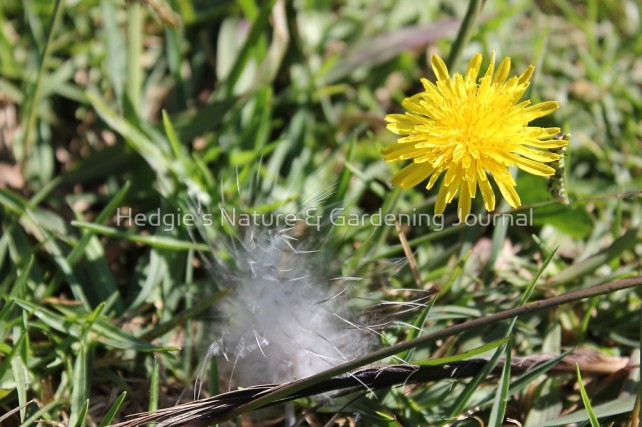
















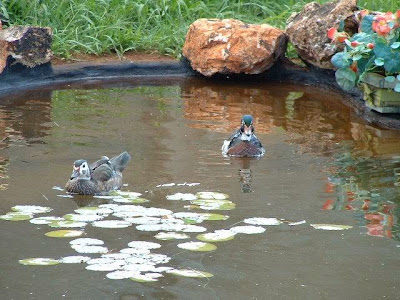








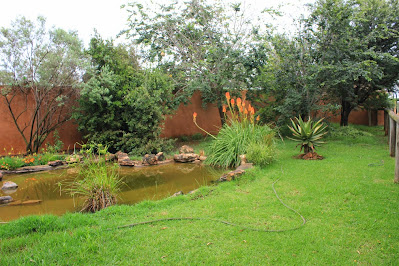






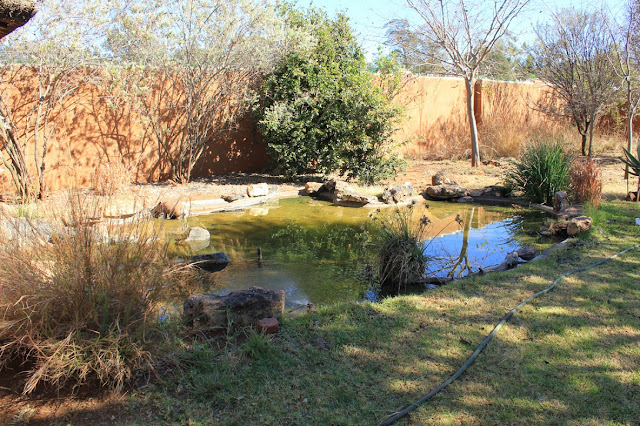








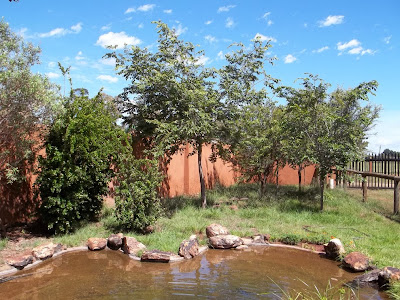







2605cropped.jpg)














